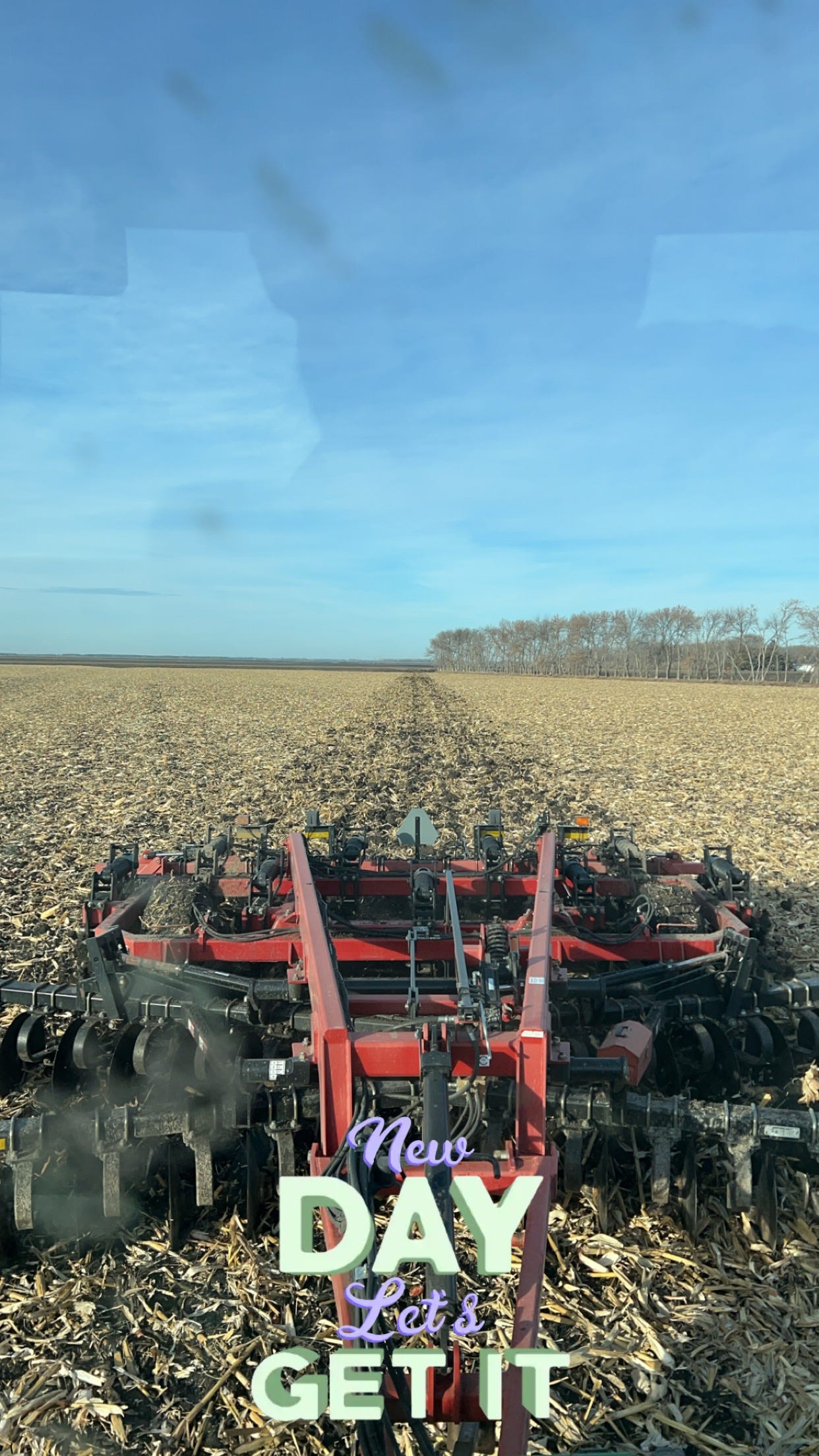December Ripping
As I work the final tweaks to this week's edition, it finally resembles December outside.
On a typical year, when you get this far north, the machinery goes into hibernation in early November.
The good news for us?
Nothing was typical in 2023, and it wrapped up with one of the most bizarre things I’ve ever seen this far north of the Continental Divide: deep December tillage.
Strange as it was, we wrapped up our business with record-setting temperatures and put the equipment to bed.
We were darn fortunate to get this weird weather window to prep the ground for next year.
That extra month of decent weather should make this winter seem short. What a bonus.
#Plant24 will be here before we know it.
Before I get back to planning for next year, I'd best whip up some pancakes and get all fat and sassy while winter does her thing outside.
If you enjoy and would like Farming Full-Time delivered to your email inbox every week, it’d mean the world to me if you mash that subscribe button below.
With that, we’ll get on with it.
The Sunk Cost Fallacy
How difficult is it for you to say no to something?
I don’t mean declining tacos when they’re offered. Nobody is that ridiculous.
I’m talking about when forced with a challenging decision like letting a piece of rented land go when the landlord demands seven hundred schillings an acre, Taylor Swift tickets, and a shoe shine.
But I’ve got so much invested! I can’t give up on it now!
Nonsense.
What’s done is done. Spent money can’t be unspent.
So why chase after land that becomes unprofitable?
Why rob Peter to pay Paul?
Have you ever set a pile of money on fire? It’s pretty much the same thing. I’m willing to bet that most of us have at some point.
Furthermore, many do it all the time.
I can’t let that land go. I’ve put far too much time and money into it.
Wheat is 28% off its highs. I’ve already lost so much. Why would I sell now?
And then there’s my favorite: We’ve got so much invested in this crop. We can’t quit spending money now!
So many of us remain committed to plans after we know the plan is fubar.
Introducing the sunk cost fallacy.
What is the sunk cost fallacy?
The Sunk Cost Fallacy describes our tendency to follow through on a project if we have invested time, effort, or money into it, whether or not the current costs outweigh the benefits.
I see people (myself included) constantly falling for this cognitive bias, and it's not only limited to farmers.
Everybody falls for the mind’s blind spots.
Doctors, lawyers, plumbers, and not even investment bankers are safe from the sunk cost fallacy.
You might say, well, I’d never do that. I know when to cut my losses and run.

Do you?
How often have you held onto commodities because the price was higher yesterday, so you wait years for a rebound?
How many of you farmed a piece of unprofitable ground because you spent time improving it?
The sunk cost fallacy is not limited to financial decisions.
We’ve all encountered a couple who continues to stay in a relationship despite knowing it's not working out.
They are holding on to the relationship because they share a history, and it isn't easy to let go.
Instead of facing reality and moving forward, they continue to invest more in the relationship, hoping for a better outcome even though the thought of spending time with the other person makes them want to vomit.
It makes no sense.
Let Go
When something no longer benefits us, we need to let it go.
Just because we invested time, dollars, or energy into something doesn’t mean we have to buy it an engagement ring, say I do, and commit our lives to the cause.
Learn to be aware of blind spots like the sunk cost fallacy.
Accept that sometimes it’s best to cut the cord.
If it’s not working for you, let that land go to the higher bidder.
End that relationship that’s no longer serving you.
Forget about your sunk costs. Instead, focus on the best decision moving forward.
Let it go.
High-Dollar Machinery
With quarter-million-dollar Peterbilts and seven-figure Quadtracks and X9s, one has to wonder.
What on earth is going on with the price of farm machinery?
Did somebody put something in the water?
Perhaps legalized dope gave everybody a contact high.
It seems madness when people drop almost six figures for an auger tractor with a cab barely large enough for a Shih-Tzu.
It wasn’t long ago when John Deere dealers gave away 4440s as stocking stuffers for the homeless.
These things tend to be cyclical, but perhaps it’s different this time.
Have we seen the high water mark in machinery prices or reached a new era where fifty-year-old tractors cost the same as a new Ford Raptor?
Your guess is as good as mine.

Adoption Takes Time
When America’s budget deficit was still in the billions, not trillions, the world worshiped Paris Hilton, globalization, and the Bush II tax cuts; hardly any farmer had autosteer on their machinery.
The John Deere salesman was peddling this new product back then, which seemed more like a gimmick than farmers would pay for.
What the hell do you need that for? Gramps quizzed as his son passed the check to the salesman for something that seemed utterly pointless.
With $4 spring wheat and $6 beans, investing in tractors that steered themselves seemed nonsensical, almost heresy.
For two years, the old farmer refused to touch the Greenstar Brown Box (IYKYK).
To his credit, he was one of the township’s straightest tractor drivers, and he took a lot of pride in that.
I get it. There was a time when I could chisel plow pretty straight, too.
Now, if I had to farm without autosteer, it’d look like somebody was chasing a snake. I’m confident many agree since few guys are left without the technology.
Even the die-hard anti-autosteer guys came around.
Skip ahead to 2007, when Americans stopped paying their mortgages, and Bob Barker hosted his last episode of The Price is Right.
It’s rare to come across a farm in our part of the world where farms are not utilizing some automatic guidance system.
That same old-timer who once refused to let the tractor chauffeur him forth and back was now addicted to keeping his hands off the wheel and focusing on his I Can’t Believe It’s Not Butter container full of jelly beans.
Hot tip: If you ever stumble across an old man’s stash of jelly beans, DO NOT eat the entire thing in one go.
Shitting rainbows isn’t as fun as it sounds.
Anyway, it’s the fall of 2007, and we combine wheat while Gramps chisel plows behind us when my Motorola Droid rings.
Adam, the damn thing kicked off again. How do I get this steering working?
Sometimes, Gramps struggled with remembering what buttons to press, and I’d have to go back out and walk him through the autosteer setup process.
Eventually, I taped an instruction sheet/flow chart to the armrest to reference when he got lost in the recesses of the brown box.
It worked well and kept the distress calls to a minimum, but as many of you might remember, in those days, sometimes the autosteer just needed a few hours off.
It’s like the OG Brown Box was a labor union member.
After a short spell, sometimes a few minutes or hours, the autosteer would return and start working like nothing ever happened. It was like a family who refused to speak of problems, brushing them under the rug instead of resolving them.
After a few minutes of fiddling, I told Gramps it was just one of those days. Give it some time, and it’ll finish its lunch break and return to work.
Heck with that noise, he retorted.
I’ll come back tomorrow and finish.
It hadn’t been five years, and Gramps flip-flopped his tune harder than a politician.
The guy who told us autosteer wasn’t necessary, a waste of funds, a gimmick, was now more hooked than a junkie to the marlin spike.
He wouldn't run it if the tractor didn’t steer itself.
Five years was all it took.
Eventually, the majority adopts new technologies—the wheels of progress roll on to the next thing.
This is the way of the world.
Though we are getting quicker, it seems like we’re always slow to adopt new technologies, but once a few people realize something is worth adopting, the masses trip over one another to follow.
Crying Wolf
Today, it’s the same with biologicals.
For decades, sales agronomists brought us snake oils to spray on our crops, each as worthless as the next.
I’ve always been a sucker for finding something that will protect our crops and increase yields.
Like it was Christmas in July, a salesman from a big-box farm store brought me a different snake oil every spraying season.
Every year, I’d come back in the combine and watch the yield monitor like our dog Lewis watches squirrels, giddy to see the results.
They were the same every year.
Inconclusive.
Snake oils with a side of rubbish.
After twenty-five years of disappointment, the market has finally delivered biological products that work as designed, but the industry cried wolf so many times that farmers are no longer interested.
Can you blame them?
Other companies seem to be having trouble changing the biological narrative as well.
Upon hearing the word biologicals, many farmers will run in the other direction. So, some companies are abandoning the word entirely in exchange for something a little more hipster-friendly, like Naturals.
Maybe that’ll work, or perhaps it won’t. I’m no marketing expert, and I’m even worse at understanding people and what they want.
But I do know what will show farmers the light-time.
As shown in the chart above, farmers will accept the benefits and high returns on investment that modern biologicals offer, just as they did with previous innovations such as truck tarps, Allis Chalmers Stadium Lighting, and, yes, automatic tractor guidance.

These Things Take Time
The walls will come down as long as we continue producing biologicals that perform.
Biologicals will be like Krispy Kreme Donuts in the early 2000’s-everywhere, without the disastrous tumble into obscurity.
Okay, that was a bad analogy, but I think it makes my point.
Biologicals are the real deal.
We enjoyed bitcoin-like returns on this stuff in 2023.
Biologicals are like having a money printer on your farm.
The only way to find out for yourself is to take the plunge.
It took only one year for us to see that biologicals are worth placing on every acre.
Sooner or later, biologicals are going to be as common as autosteer.
Some like to show up in the early stages of the innovation adoption cycle, while others don’t mind waiting to hop on with the late adopters and laggards.
We all ride at some point on the innovation curve.
The guys late to the California Gold Rush had nothing but rocks in their pans.
Those comfortable taking small risks to embrace new technologies early are raking in the real coin.
Dip your toes and test the waters.
Start small and see for yourself.
The snake oil days are behind us, and the biological revolution has begun.
Take your seat on the curve before all the good spots are gone.








